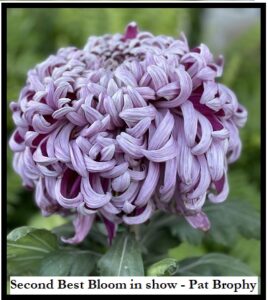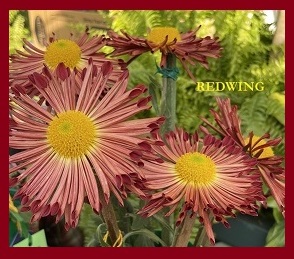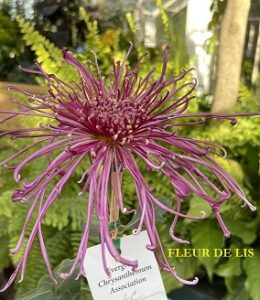Cultural highlights for our April Meeting followed by our traditional to do list:
April is always one of our strongest meetings of the year with hundreds of rooted cuttings for sale. This year there is more, so much more. At the January board meeting we talked about improving our meetings with some interesting speakers and covering the full range of Chrysanthemum classes.
We start the April meeting with the Diva of Early Mums, Nancy Halleen, who is going to tell us exactly how much we are missing by focusing so much of our attention on Lates.
Next it’s quickly back to soil mixes. At the March meeting I talked about the importance of increasing air near the roots and the possibility of adding more Pumice to the soil mix. I grow in a 60% – 40% mix of M & R Soilless and Harvest Supreme Compost. Looking back through all of the cultural notes I see Don has the same mix but has also been adding 1-2 parts more of pumice. I guess I don’t always listen well enough, as Don’s mix is spot on in terms of creating a better soil mix capable of holding more air. I’m finally on the same soil track as Don this year.
Next it’s fertilizers where I often seem to have more questions than answers. e.g. If we are using the right fertilizer amounts, why were over 50% of blooms exhibited by some experienced growers fully or partially blown last Fall? ECA has made a several major changes in soil mixes over the last 40 years. I joined the club at a time when we grew almost entirely in M & R mix which has a very fast release of fertilizer. Today’s recommended mix of composts, and M & R soilless has a very much slower release soil. Yet as far as I can tell we still have the same fertilizer recommendations that were developed by Jim Ball and his Brother in Law for soilless mixes in the late 1980’s and early 90’s. Can this be right?
Plant accidents are still happening. Rumor has it that four very healthy Connie cuttings accidently fell into a birthday gift of slippers sent to Phil Gurr in Scotland. Phil has successful created many new Chrysanthemum cultivars over the years and was desperately in need of good Connie seeds to create new varieties this Fall. His latest releases are earlies (24 & 25’s) Maybe some will accidently find there way here!
When it comes to getting more interesting speakers to ECA it doesn’t get any better than having Ivor Mace from the UK present and talk to us. He is one of the world’s leading Chrysanthemum experts and has won more awards and trophies for Large Exhibition Chrysanthemums than anyone else. Before Ivor made his flight commitments I sent a quick email straw poll to 40 members asking if his visit would be of interest. 32 members simply chose to ignore my e-mail and said nothing. 8 responded with a yes. Is this pathetic response all ECA can muster with only 8 people wanting to meet Ivor Mace ? We simply have to do better and have gone forward with Ivor’s visit scheduled for Saturday 29th November. I’m hopeful an evening reception can be organized for him((Wine and Hors d’oeuves) followed by his Power Point presentation – Growing large Exhibition Chrysanthemums plus images from the UK 2014 National Show. We seek a small inexpensive room where we can hold the reception, bringing our own wine and eats. South of Seattle would probably be the most convenient area for ECA members. Ivor will be staying downtown Seattle.
APRIL TO DO LIST (edited from DRS 3-21-05)
1. Potting on mums into 4” or 6” pots
· Soilless growers who are using the club recommended M&R mix. This mix is ph balanced at 6.5 and contains a good mix of fertilizers that carry the plant for 3-4 weeks. It requires no additives at this time, but some growers like to add a little Alfalfa meal and some additional pumice for increased aeration.
· Soil or compost mixes: See McGlashen mix in the McGlashen Hand Book. You’ll need to mix your own soil, consisting of compost, or garden loam plus slacked Lime or Dolomite to keep soil sweet plus Steamed Bone to promote root growth. Also, ashes and a little Rose and garden fertilizer (i.e. 4-10-8 or 5-10-10) Pumice or grit may be added to loosen the soil mix.
· Wash previously used pots in a mild Clorox bath (bleach), then rinse in clear water.
· Clay pots are recommended for 4 or 6 inch potting as they breathe and dry out faster during cool April days.
· Pot on when a significant ring of roots forms around the bottom edge of the pot (semi root bound). Do not compact the potting mix. Tie plants to small stakes.
2. Move mum pots outdoors as weather warms. Choose a sunny location.
· Bury pots to rim if using clay. Protect from frost, wind, dogs, cats and Children.
3. Review stopping dates. Most ECA cultivars are stopped Between April 15 and May 30.
· Pinch date lists for most club cultivars should be available at the April meeting. Contact your Coach for other cultivars not on the list.
4 OTHER CARE:
· Control Aphids. Spray for Aphids every 2 or 3 weeks, with liquid Diazinon, or other insecticides. Water only as needed, do not over water.
· Continue culling process in April to get to your final growing group. The 6” potting should be used for this reduction. Don’t always keep the first plants to reach 6” potting stage. Keep the best cultivars. Share surplus plants with other club members. Throw away damaged or diseased plants.
Fertilize weekly starting the 3rd or 4th week after potting. Standard Miracle Grow is recommended. Water soluble 10-50-10 Peter’s upper blossom booster is also a good substitute.
(Please note the change in recommendation for starter fertilizer. In 2009, Don Stark indicated that water-soluble 10-50-10, Peters Super Blossom Booster plant food, is available at local garden stores or McLendons Hardware in 1.5-pound bags. The application directions indicate 1 tsp per gallon of water for indoor use. Use this fertilizer as a supplement through the 6” pot stage. Don noted that Peters 20-10-20 will be available for use through the summer growth season.)




